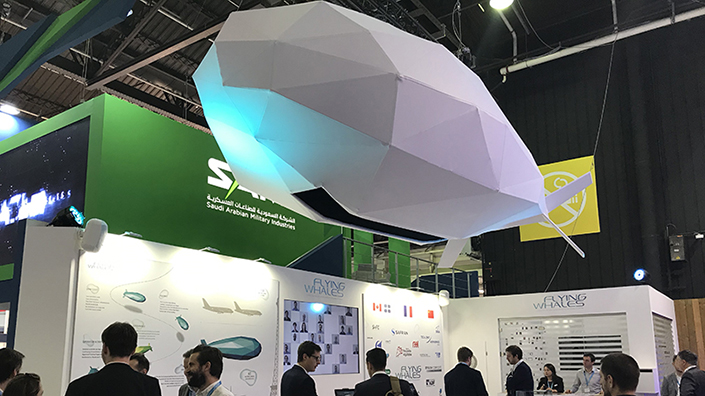Engineering news
Looking like something from an early 1990s video game, a polygonal model airship from French company Flying Whales hangs above delegates’ heads in hall 2A of the Paris Air Show.

The model airship
The blimp is not exactly representative of how the company’s final aircraft will look, says aeronautic and design engineer Nicolas Weisse to Professional Engineering, as the production airship will have much smoother conventional aerodynamic covering. The model does have one key feature, though – the gaping cargo bay in its belly, stretching almost from tip to tail.
The company says its helium-lifted LCA60T will be the world’s largest cargo delivery airship when it launches in 2022, and the hold will be 80m x 8m x 5m. Although the largest offshore wind-turbine blades are fast outstripping those dimensions, Flying Whales says its vehicle could be ideal for transporting several onshore turbine blades at a time – either in the hold or in a yet-to-be-designed hanging frame designed to minimise wind catching the blades while in flight.
The aircraft will have a rigid structure of carbon-fibre lattices, says Weisse. “It’s not the pressure that gives the shape, but we have a gas bag inside the airship and the shape is given by the structure.” Ten cells will contain the helium, with space to let it expand to 98% of volume at the maximum altitude of 3,000m. It will cruise at about 100km/h.
Up, up and away
Using airships to deliver massive payloads of up to 60 tonnes will bring a major engineering challenge, says Weisse. “It is not like a helicopter – when we land a blade, we lose some weight, so if we don’t take another weight we are going up in the air, higher and higher like a Mickey Mouse balloon.”
They plan to use water as ballast. Pumps installed at delivery sites will send water up to the ship to prevent it from rising uncontrollably after delivering cargo. Pick-ups will require the pilot – one of just two crew members alongside a loadmaster – to spray water out in rain-like drops to prevent dangerous, potentially flooding dumps.
The company hopes several propellers, electrically powered by an internal fuel turbine, will make the aircraft highly manoeuvrable. It has at least five, including a swivelling lateral propeller.
Despite the high level of control, Weisse says the LCA60T will not be able to lower blades into position at the top of turbine towers to be connected in-flight. “It could be possible, but not with this technology,” he says. “The market we’re developing is to land the wind blade close to the tower.”
Onshore boost
Such a system could be useful in the UK, where clean energy organisations such as Renewable UK are urging the government to allow more onshore windfarms. Other countries are more receptive to the technology and have bigger installations.
The airship’s principal use, however, might not be so popular with the renewable energy sector – the original reason for the project was a mission from the French state, which wants to use it to access remote and difficult-to-reach forests for logging.
Content published by Professional Engineering does not necessarily represent the views of the Institution of Mechanical Engineers.